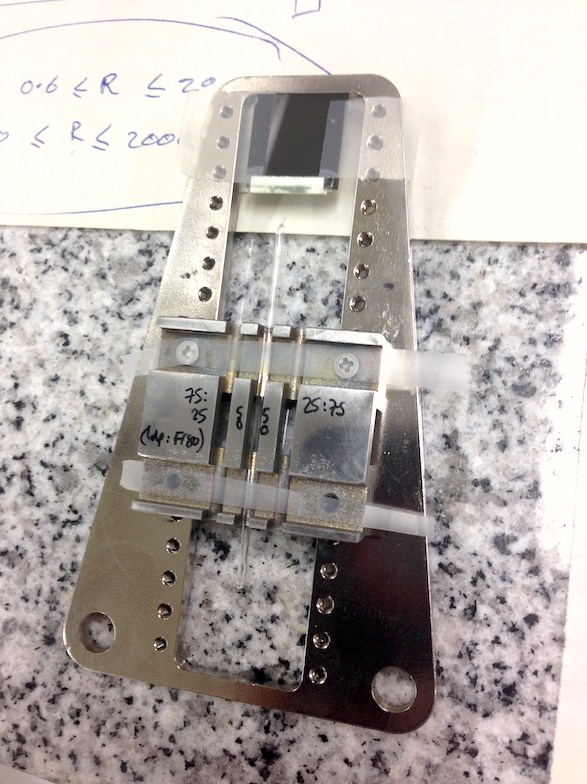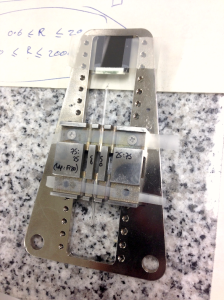
Dear readers,
As you read this, I’ll be trying to get to the Denver X-ray Conference in Montana. I’ll be giving a talk there on Friday morning introducing small-angle scattering to fellow X-ray afficionados and hopefully convert a soul or two to the narrow field we’re in. Please come and say hi if you’re around, or contact me on my twitter account (connectivity permitting), user @drheaddamage. I have two small bits I want to talk about today: a new sample holder and 3D SAXS.

Secondly, I have stopped trying to construct a straightforward sample holder for liquid samples for now, and designed a holder for 1.5 to 2 mm capillaries instead. I am not a fan of capillaries, and this should not be seen as an endorsement of them, but in some cases they seem to be a good way of containing volatile liquids in vacuum. It’s nothing fancy, but the drawing is here: Capillary holder technical drawing. I must say, it does help tremendously if you have a wire EDM cutter in the workshop, as this holder has been designed to be cut in that. Anyway, performance is fine of the piece, although 1.5mm capillaries do have a bit more room than I had expected. The final result is shown in Figure 1.
A third thing I wanted to discuss at length but can’t is 3D SAXS. During my European Tour, this question came up a few times: can we resolve all aspects of a particular scatterer by collecting the 3D scattering pattern through rotation of the sample? The simple answer is “probably”. If we have a sample with scatterers with a very well defined shape and orientational relationship to the sample, we can, through rotation of a single, well-prepared sample, collect the entire 3D scattering volume (note: when we record a 2D scattering pattern, we are actually only collecting a slice through the centre of the full 3D Fourier space. By rotating the sample, we can collect many such slices at a variety of angles, and reconstruct the 3D Fourier space).
Through analysis of this volume, we should then be able to determine the exact orientation in 3D of the scatterer and its complete morphology. It can be achieved, for example, by adding a third dimension to the 2D MC analysis presented in this arXiv paper (for example). Naturally, others have thought about this as well, and Peter Fratzl in particular has been involved in much of this work.
Unfortunately, I cannot write much about this simply because most of the literature is inaccessible to me. The papers in the list below are all in journals I don’t have a subscription to, and a quick Google search did also not result in a freely available PDF for these articles (authors or institutes sometimes have their own free repository to support so-called “Green Open Access“). Therefore, since these articles are not available, I cannot read and therefore not discuss about them. Knowledge held hostage by journals, available at their steep price only.
So, for your perusal, the one I could read, and the four I couldn’t:
3D SAXS reference:
- P. Fratzl, F. Langmayr and O. Paris, “Evaluation of 3D Small-Angle Scattering from Non-Spherical Particles in Single Crystals”, J. Appl. Cryst. 26 (1993), 820-826
Maybe 3D SAXS references (inaccessible to me):
- [ed: since supplied by a kind colleague:] Guenther Maier, Gernot Wallner and Peter Fratzl, “3D Small Angle X-Ray Scattering (SAXS) on deformed PVDF Foils”, 2003 MRS Fall Meeting, J. Phys. IV France 03 (1993) C8-325-C8-328, DOI: 10.1051/jp4:1993865
- [ed: since supplied by a kind colleague:] F. Langmayr, O. Paris and P. Fratzl, “Shape and size of non-spherical particles in single crystals, investigated by SAXS”, Zeitschrift für Metallkunde, Vol. 96, No. 4, Pages 325-334
- [ed: since supplied by a kind colleague:] Ralph Gilles, “Neutron scattering, a powerful tool in material science considering superalloys as an example”, doi: 10.3139/146.018125
- Robin Seidel, Aurelien Gourrier, Michael Kerschnitzki, Manfred Burghammer, Peter Fratzl, Himadri Shikhar Gupta, Wolfgang Wagermaier, “Synchrotron 3D SAXS analysis of bone nanostructure”, Bioinspired, Biomimetic and Nanobiomaterials
I hope to be able to post about DXC in the coming week. Until then!

Leave a Reply